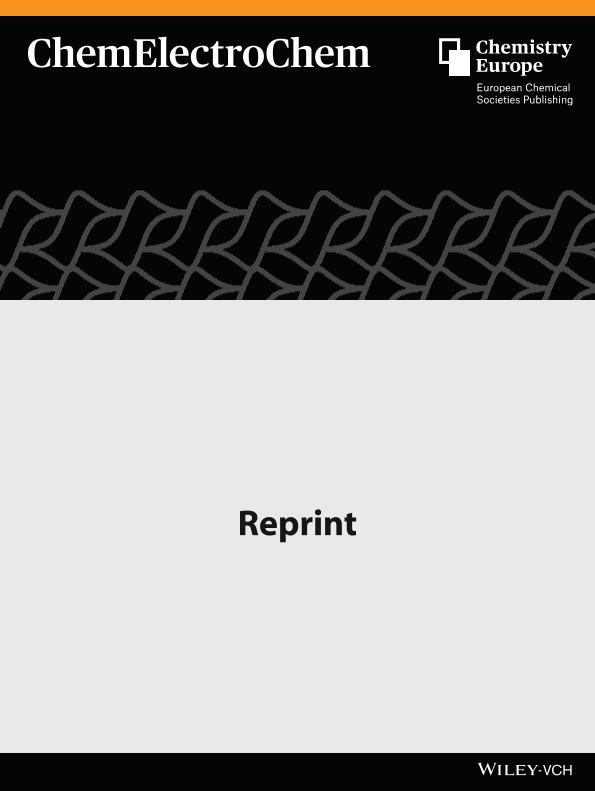Mostrar el registro sencillo del ítem
dc.contributor.author
Regiart, Daniel Matias Gaston

dc.contributor.author
Kumar, Abhishek
dc.contributor.author
Gonçalves, Josué M.
dc.contributor.author
Silva Junior, Gilberto J.
dc.contributor.author
Masini, Jorge César
dc.contributor.author
Angnes, Lúcio
dc.contributor.author
Bertotti, Mauro
dc.date.available
2023-06-26T13:58:00Z
dc.date.issued
2020-04
dc.identifier.citation
Regiart, Daniel Matias Gaston; Kumar, Abhishek; Gonçalves, Josué M.; Silva Junior, Gilberto J.; Masini, Jorge César; et al.; An Electrochemically Synthesized Nanoporous Copper Microsensor for Highly Sensitive and Selective Determination of Glyphosate; Wiley; ChemElectroChem; 7; 7; 4-2020; 1558-1566
dc.identifier.uri
http://hdl.handle.net/11336/201506
dc.description.abstract
A nanoporous copper (NPC) film was electrodeposited on a copper microelectrode, and the generated platform was investigated for electrochemical sensing of glyphosate (Glyp). The as-deposited NPC film was highly pure and crystalline according to results of energy dispersive spectroscopy and X-ray diffraction experiments, respectively. Scanning electron microscopy images confirm the NPC films possess a highly porous morphology containing dendrite fractals, and the electrodeposition parameters, particularly potential (Ed) and time (td), exert a remarkable influence on the structure of the films. Such changes in the NPC morphology with Ed and td were also correlated with the electrochemical behavior investigated by cyclic voltammetry. In the presence of Glyp, the anodic oxidation is facilitated because copper ions diffuse easily through the pores of the NPC film and form a complex with the analyte at the electrode interface. On the other hand, as the amount of copper oxides decreases due to the formation of soluble Cu(II) complex with Glyp, less current is obtained during the reverse scan, allowing a relationship between the decrease in the cathodic current and the Glyp concentration to be established. The optimized NPC-modified Cu microelectrode showed very high sensitivity (14 nA nmol−1 L), low detection limit (4 nmol L−1), excellent reproducibility, and selective response for Glyp. The applicability of the sensor was demonstrated by detecting Glyp in river water samples.
dc.format
application/pdf
dc.language.iso
eng
dc.publisher
Wiley

dc.rights
info:eu-repo/semantics/openAccess
dc.rights.uri
https://creativecommons.org/licenses/by-nc-sa/2.5/ar/
dc.subject
COPPER MICROELECTRODE
dc.subject
ELECTROCHEMICAL SENSOR
dc.subject
ENVIRONMENTAL SAMPLES
dc.subject
GLYPHOSATE
dc.subject
NANOPOROUS COPPER
dc.subject.classification
Química Analítica

dc.subject.classification
Ciencias Químicas

dc.subject.classification
CIENCIAS NATURALES Y EXACTAS

dc.title
An Electrochemically Synthesized Nanoporous Copper Microsensor for Highly Sensitive and Selective Determination of Glyphosate
dc.type
info:eu-repo/semantics/article
dc.type
info:ar-repo/semantics/artículo
dc.type
info:eu-repo/semantics/publishedVersion
dc.date.updated
2022-05-06T16:16:41Z
dc.identifier.eissn
2196-0216
dc.journal.volume
7
dc.journal.number
7
dc.journal.pagination
1558-1566
dc.journal.pais
Países Bajos

dc.description.fil
Fil: Regiart, Daniel Matias Gaston. Universidade de Sao Paulo; Brasil. Consejo Nacional de Investigaciones Científicas y Técnicas; Argentina
dc.description.fil
Fil: Kumar, Abhishek. Universidade de Sao Paulo; Brasil. Universite de Bourgogne; Francia
dc.description.fil
Fil: Gonçalves, Josué M.. Universidade de Sao Paulo; Brasil
dc.description.fil
Fil: Silva Junior, Gilberto J.. Universidade de Sao Paulo; Brasil
dc.description.fil
Fil: Masini, Jorge César. Universidade de Sao Paulo; Brasil
dc.description.fil
Fil: Angnes, Lúcio. Universidade de Sao Paulo; Brasil
dc.description.fil
Fil: Bertotti, Mauro. Universidade de Sao Paulo; Brasil
dc.journal.title
ChemElectroChem
dc.relation.alternativeid
info:eu-repo/semantics/altIdentifier/doi/http://dx.doi.org/10.1002/celc.202000064
dc.relation.alternativeid
info:eu-repo/semantics/altIdentifier/url/https://chemistry-europe.onlinelibrary.wiley.com/doi/10.1002/celc.202000064
Archivos asociados
